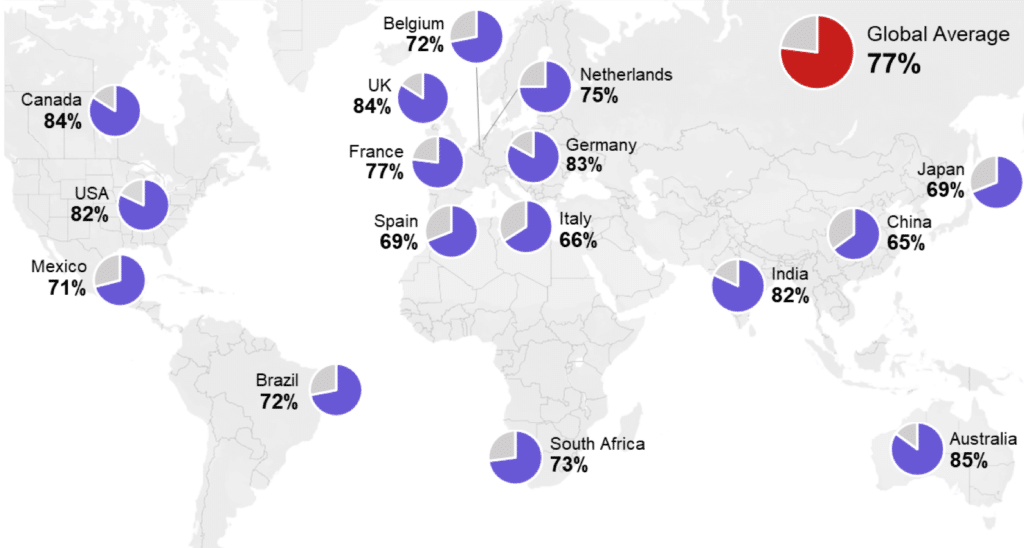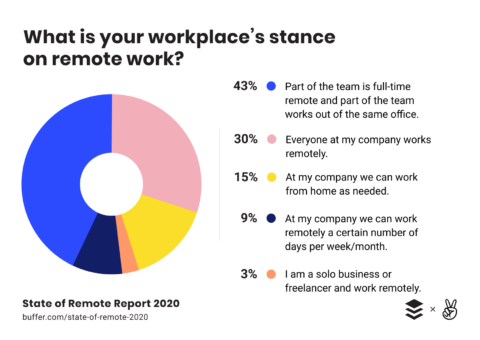As major corporations like Facebook, Twitter, and Shopify announced permanent work-from-home policies, companies around the globe began to wonder if they too could join the full remote wave. Going full-time remote is an attainable goal for many businesses, especially if temporary remote work setups have been a success. We’re here with the remote work tips you need to make an effective transition.
Ways to structure your remote working initiative
In a traditional office structure, employees are hired in part based on physical proximity to the company’s location. Employees are expected to show up every day during opening hours and perform their jobs on-premises. This limits hiring managers to the local talent pool and restricts employees to living within commuting distance, not to mention the day-to-day costs incurred by both sides.
As you know, remote working is an alternative to office work. What you may not be familiar with is the fact that there are various different ways to structure remote working. These fall into two categories: local remote and full remote.
Local remote
With a local remote working strategy, employees are physically located near their company’s office but don’t commute to work every day. Employees may come in on certain days and take advantage of part-time flexibility or work from home five days a week. This is the model that most companies have adapted following the coronavirus pandemic.
Local remote has its advantages. Employees can still be called into the office for meetings or face-to-face interactions with clients while maintaining a bit more flexibility in their personal lives. But there are also certain drawbacks. Companies still have to pay to maintain a physical office space, and they aren’t as free to hire from the global talent pool.
Full remote
Companies that have adapted well to local remote work following COVID-19 may consider going full remote moving forward. With this strategy, current local employees are given the freedom to stay where they are or move anywhere they wish.
Full remote isn’t an option for every company. The ‘end of the office‘, might not be feasible. For example, if you deal with clients in person, this may not be the right choice for you. On the other hand, it could be possible to let some departments go full remote while keeping client-facing roles in a local office. The right remote work solution is different for every organization.
Benefits of full remote work
No one would consider adopting a remote work model if there weren’t benefits associated with it. You may have noticed some advantages to working remotely on a temporary basis during the pandemic, but there are even more rewards to be discovered from making the shift permanent. Here are just a few of them:
Hire from a global pool of talent
You can also choose to make some internal functions remote while keeping others local. For example, you may benefit from hiring engineers remotely but maintaining a local customer service team. The latter may still need to interact with clients face to face, but even if they don’t, customer satisfaction tends to go up when service professionals are nearby. This strategy won’t limit the costs of running an office entirely, but it will certainly reduce them.

Reduced expenses
Eliminating offices reduces costs both for employers and employees. According to Global Workplace Analytics, a company with 50 employees that goes full remote could see financial gains of more than $900,000 per year, while employees would save $5,354 in expenses and 23 days in time spent commuting annually. Use the organization’s Telework Savings Calculator to see how much your company would save by going full remote.
Increased productivity
It’s commonly accepted that employing remote workers is associated with better employee productivity. This phenomenon has been widely studied, and the exact measure of how much more productive remote businesses become varies. For example, the Harvard Business Review found that the U.S. Patent and Trademark Office saw a 4.4% increase in output from employees who took advantage of a work from anywhere program, while a similar study from Stanford found a 13% productivity increase. Wherever your company falls within this range, even a small increase in productivity is likely to manifest itself in areas such as profitability and customer satisfaction.
Remote work tips for going full remote
Committing to fully remote requires a few changes in the way you do things in an office or even as a local remote team. Consider these remote work tips to make sure your evolving structure doesn’t leave anyone behind.
Stay connected
Communication is easier when everyone is in a central office. Not everyone anticipates the conscious effort that goes into staying connected from a remote workspace, which can come as quite a culture shock. Empower your workforce with plenty of digital communication tools and encourage managers to make themselves available as often as possible in addition to scheduling regular feedback sessions.
As you bring additional employees into a remote organization, you’ll also need to rethink the onboarding process to make sure every new hire gets the attention they deserve. First and foremost, make sure a thorough training on remote working technologies is included early in the process so that employees have access to all the communication tools available to them. You might also consider making a company-wide announcement welcoming new employees and encouraging others to introduce themselves virtually.
Set a schedule
When companies go remote, they typically abandon the 9-to-5 schedule that was maintained through office hours. If employees are in different time zones, this could get tricky as disjointed work schedules often lead to significant delays in back-and-forth communications.
To make sure everyone is on the same page, consider setting certain a few hours during the week when employees are expected to be online. This is a great time to schedule all-hands meetings and team video calls, make company-wide announcements, and give everyone a chance to have direct conversations as needed.
Remote work scheduling may apply differently to client-facing roles. If you have a customer service line, for example, that needs to be manned during specific hours, someone from that team must be available at all times, requiring a much greater degree of coordination. For companies that handle customer service via message or email, a better strategy could simply be to establish a minimum response time, such as one hour during the business day. This gives employees a certain amount of flexibility as long as they check their emails at least once per hour.
Track data
The only way to truly measure the benefits of going full remote is to carefully track data and monitor changes over time. Before you begin the full remote transition, decide which KPIs you’ll use to measure productivity and success. Here are a few ideas for data points to watch:
- Usage of remote tools
- Time spent in video calls
- Average project completion time
- Employee turnover
- Customer satisfaction
- Sales volume
- Profitability
Clearly define remote work policies
Your current company policies probably don’t reflect a fully remote work structure. Before you make remote work a permanent change, review policy documents and update them to clearly define the expectations of remote employees. Of course, you should clearly communicate any policy changes to the entire workforce and open the door for feedback and questions.
Enable remote working with a digital workplace
Companies that go remote are constantly looking for ways to shorten the distance between employees that aren’t working in the same physical location. The best solution is to utilize an intranet as a centralized hub where the entire company can congregate virtually. Through an intranet, employees can access files, communicate, and work together in real-time just like they would if they were sitting in the same room.
Powell Software for full remote work solutions
With the many digital tools that are needed to support a transition to full remote work, an all-inclusive solution is the way to go. Powell Software provides just that with a customizable intranet designed to maximize remote working efficiency. Powell Intranet leverages the power of Microsoft technology, including Office 365 and SharePoint, with the added benefits of no-code customization and third-party widget integration. We can also help companies that decide to follow a local remote structure. Flex Desk is a widget that enables hot-desking so employees can book their desk for in-office days. Discover more about Powell Intranet.
Setting your team up for remote work success can seem daunting at first. There is a lot to consider to ensure a smooth transition. Fortunately, with the right planning, your team can thrive in their remote roles. We’ve put together this comprehensive guide to help you make the move to remote work.





